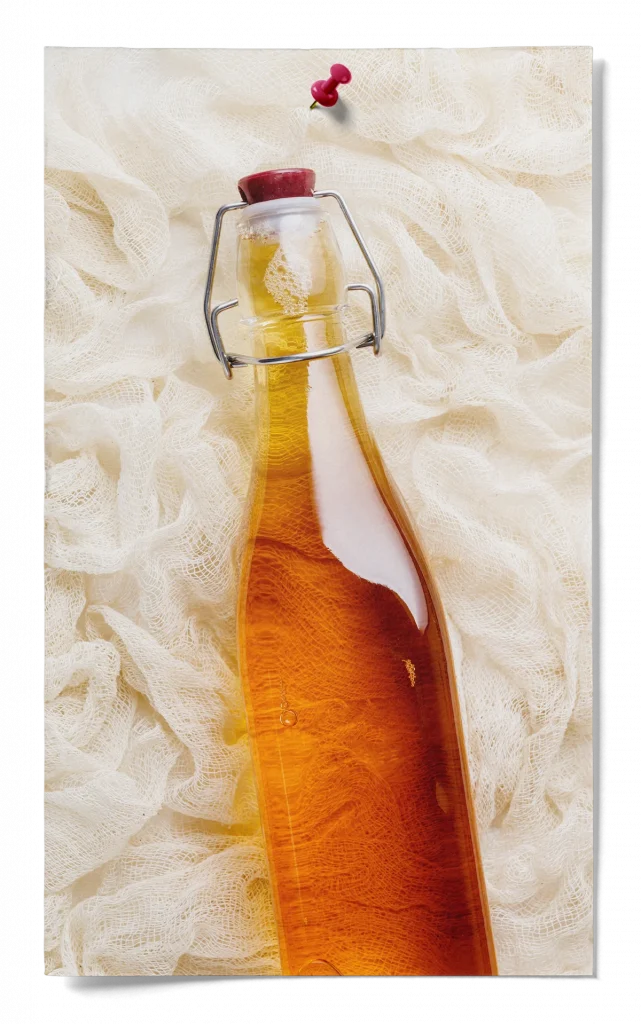
Peaches puree up into a luscious, creamy consistency that results in a smoothie-like kombucha. In fact, it would be a delicious addition to a smoothie. Enjoying it on it’s own is plenty enough to satisfy that in-between meal tummy growl and get you back focused on the tasks at hand.

Brewing kombucha is almost always a two-step process. Brewing kombucha is only a one-step process for those who prefer still kombucha. Otherwise, the steps consist of primary fermentation and secondary fermentation.
It’s important to note that brewing homemade kombucha is almost always a two-step fermentation process. Brewing kombucha is only a one-step process for those who prefer an unflavored flat kombucha. Otherwise, the steps consist of a primary fermentation and secondary fermentation.

The primary fermentation is the first step of the kombucha brewing process. This is where your SCOBY transforms the sugar in the sweet tea into the tart and slightly sweet kombucha we love. At the end of this stage, you will have kombucha but it will be unflavored and flat.

This is the step where you bottle your kombucha. In addition, this is where you carbonate and/or flavor your kombucha by the addition of sugar and flavors. This step involves adding a bit of sugar or flavor to bottles with lids designed to hold the pressure of fermentation and then letting them ferment a little longer, allowing the yeast to carbonate the beverage in an airtight environment naturally. Have questions on the process? See our guide on kombucha secondary fermentation here.

This recipe makes one 16-fluid-ounce bottle. A 1-gallon batch of kombucha will make seven 16-ounce bottles, so for one gallon, you will need to multiply the ingredients by 7. Before beginning this recipe, you will need to:
16 FL Oz Bottles
10
minutes1-3
DaysThis Peach Kombucha Recipe is for one 16 fluid ounce bottle. For a gallon batch, make seven bottles. To scale this recipe to a gallon batch, multiply the ingredients by seven or toggle the serving size up to seven above. Before bottling your kombucha, remove the SCOBY pellicle along with 12-16 ounces of kombucha starter tea from your brew, and reserve for your next batch.
16 OZ Kombucha from a completed primary fermentation.
1/4 cup Pureed Peach
1 Spring Mint
16 Oz Swing Top Bottles
Measuring Spoons
Blender
First, make the peach puree. Cut the peach in half and remove the pit. Cut each half into quarters and toss in the blender until uniformly pureed. Sometimes it helps to add a little kombucha in the blender to help it along. Depending on how many bottles you’re making, you may need two peaches.
Using a funnel, distribute the puree to the bottles. It helps to add a little more kombucha here to thin out the puree, making it easier to pour.
Add one mint sprig (or 4-5 medium leaves) to each bottle and then fill with kombucha, leaving about one inch of head space.
Be sure to leave yourself enough kombucha to use as your starter for the next batch, about 1.5 cups per gallon (12 fl oz).
Tightly place the caps on each bottle.
Keep bottles at room temperature between 75-85F for 2-10 days; it will carbonate faster at higher temperatures and slower when cold.
Burp the bottles as necessary to release excess pressure. This is done by removing the cap to allow built-up pressure to escape then placing the cap back on, but try not to overdo it.
After you burp, invert the bottles so the puree that has floated to the top distributes throughout the bottle.
When you are happy with the flavor and fizziness of your kombucha (2-10 days), place bottles in the fridge to chill and halt the fermentation.
This kombucha is so good on its own. It is also great as a cocktail mixer! Gin anyone?!
